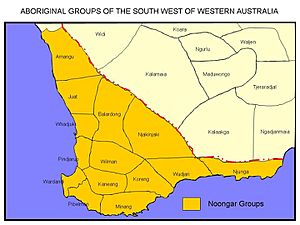Koreng facts for kids
The Koreng (sometimes spelled Goreng) are an Indigenous group of Noongar people. They come from the southwest part of Western Australia.
Contents
Language
The Koreng people spoke a dialect of the Nyungar language. This language belongs to a larger group called the Nyungic language family.
Traditional Lands
The Koreng people are the traditional owners of a large area of land. It covers about 15,600 square kilometers (6,023 square miles). This land stretches from the Gairdner River to Bremer Bay. Inland, it reaches Jerramungup and Pingrup. To the west, it goes to Tambellup and Gnowangerup.
The Koreng shared borders with other Indigenous groups. These included the Wiilman to the north, the Njakinjaki to the northeast, and the Mineng to the south. The Pibelmen were in the southwest, and the Kaneang were to their west.
History with Settlers
In 1859, European settlers began to take over Koreng lands. At that time, it was thought there were about 500 Koreng people. By 1880, just over 20 years later, their numbers had dropped to around 200.
Burial Customs
The Koreng people had special ways of burying their dead. They would dig oval-shaped pits in the sand, about 3 feet deep. The person would be placed facing east. Their knees were bent and tied. The right hand's pointer finger and thumb were also tied. This was done to make sure the person would not return from the grave.
The earth dug out for the grave was not used to fill it back in. Instead, the grave was covered with bark, rushes, and sticks. A fire was lit nearby. The person's belongings, like broken spears, were placed near the grave. Trees were marked with rings to show where the burial site was.
Stories and Beliefs
Many stories and beliefs of the Koreng people were written down in the 1880s. This was done by Edith Hassell, whose husband was Albert Young Hassell. Her writings were not well known until 1930. That's when an American anthropologist named Daniel Sutherland Davidson found them. Davidson shared this information in an English journal called Folklore in 1934–1935. These writings are still very important for understanding Koreng traditions today.
Native Title Rights
In September 2006, the Wagyl Kaip and Southern Noongar groups made a claim for Native Title. Native Title is a legal way to recognize that Indigenous people have traditional rights and interests in their land.
Other Names for Koreng
- Ko:rengi
- Kuriny, Corine
- Cororan
- Bremer Bay tribe
- Warangu, Warrangoo
- Warranger, Warrangle
- Kojonup
- Stirling tribe
- Mongup
- Kokar (east)
- Kaialiwongi (This means 'north' in the Minang people's language)
Some Koreng Words
- mam (father)
- ngangk (mother)
- twurt (tame dog)
- moakin (wild dog)
- nyituing (white person)
- nawp (baby)


